
The Tolkien Society has just uploaded on YouTube my talk for Oxonmoot 2016, titled: “Tolkien and the Art of Book Reviewing: A Circuitous Road to Middle-earth”. I thought, therefore, that it would be a good idea to publish the text of the talk and slides too. The talk focuses on Tolkien’s three book reviews on “Philology” for The Year’s Work in English Studies, published between 1924 and 1927. I start with some general observations on academic book reviews, their challenges and pitfalls (so this part may prove useful for postgraduate students and early career researchers), and then I present some links between Tolkien’s book reviews and some of his lifelong concerns and interests that fed into his literary creativity. Please note that the talk has been written to be delivered orally (rather to be published) so it includes colloquialisms and the referencing (though included) does not follow any specific referencing system religiously.
* EDIT 2019: This talk has now been slightly revised and published as the first article in the inaugural issue of AC Review of Books which can be accessed as a PDF here: https://academic-chatter.com/acrob-1-1/
Tolkien and the Art of Book Reviewing:
A Circuitous Road to Middle-earth
Dr Dimitra Fimi
Oxonmoot
September 2016
So, Book Reviews. Book reviews are undoubtedly a useful thing. If you’ve just picked up a book, any book, chances are that somewhere in the front or back cover there will be an extract from a review, attempting to convince you to read it. From the columns of national newspapers and periodicals, to the reviews submitted on Amazon, Goodreads and other such platforms, book reviews are ubiquitous, can be very influential, and – apparently – nowadays any of us can submit them.
But in the academic world, book reviews are a completely different game. Yes, they do serve the utilitarian purpose of convincing you (or discouraging you from) buying the book (perhaps for your course, or your university’s library, rather than just for you!), but they should also:
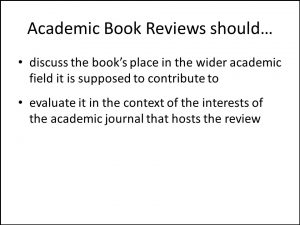 discuss the book’s place in the wider academic field it is supposed to contribute to and
discuss the book’s place in the wider academic field it is supposed to contribute to and- evaluate it in the context of the (often very specialized and niche) interests of the academic journal that hosts the review
In terms of the first point, well, book reviews are often the locus of “showing off”. Yes, says the confident reviewer, I know the field pretty well, I can explain to you VERY clearly what this book brings to the debate that is fresh and new, or I can equally rubbish it because “that’s already been said, in fact by Professor x in 1997”!
In terms of the second point, in preparation for this talk, I was having a look at book reviews of my first book, on Tolkien. (Of course I had read them avidly back then, but it was interesting to look at them again after a considerable time distance) and the review for the journal Tolkien Studies was markedly different in focus and tone from the review for the journal Folklore, or for The Times Literary Supplement. Good reviewers are supposed to cater for their readers.
At the same time, though, there are traps and pitfalls when you have a book review to do, one of which is personal relationships. Suppose you have been asked to write a review for a book written by a good friend, or esteemed colleague, or even a mentor, and you end up thinking that the book is, well, how shall I put this, not that brilliant! Academia is a small world and these things happen – how do you deal with that?
To make matters worse, all of the difficulties and intricacies mentioned so far (the wide, authoritative knowledge of the field, the clear understanding of the niche interests of your readership, AND the issue of personal acquaintances) come to a violent clash when it comes to the people who are often the ones to be asked to do book reviews more than any: PhD students or recent graduates, or early career academics.
Yes, I can feel the shivers going up and down the spines of those of you in the audience that have one due to be submitted soon! For all the reasons I outlined a minute ago, they are daunting, cumbersome and generally a rather unwelcome task. And yet, younger academics who are keen to build a track record of publications often begin with book reviews and cut their teeth in a task that is pretty tough, but can really pay off if you get it right. The best book reviews are those from which you learn something, and the exceptional ones are those that contribute to the relevant academic debate themselves via the act of critically evaluating another scholar’s work. I know, it’s tough, but it HAS to be done and it CAN be very rewarding.
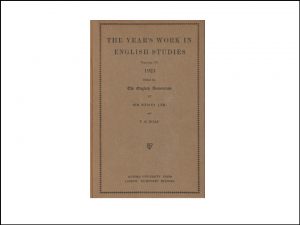 Now, why have I started this talk with such generalizations about book reviews in academia, reflecting – I assure you – on the dread and ennui of having had to do them, pretty regularly, for a good few years of my academic career? Well, because the subject of my talk is Tolkien’s own academic book reviews, all three of them, published between 1924 and 1927 in the journal The Year’s Work in English Studies (YWES). Tolkien was – at that point – exactly in the position most academic book reviewers are today: what we call now an “early career academic”. When the first of these reviews was published, he was still at his very first academic post at the University of Leeds (appointed only four years before), and by the time the last review was published he had only been in his next post at Oxford for two years. He was, therefore, within 10 years of beginning his academic career – exactly the definition we use today for early career academics.
Now, why have I started this talk with such generalizations about book reviews in academia, reflecting – I assure you – on the dread and ennui of having had to do them, pretty regularly, for a good few years of my academic career? Well, because the subject of my talk is Tolkien’s own academic book reviews, all three of them, published between 1924 and 1927 in the journal The Year’s Work in English Studies (YWES). Tolkien was – at that point – exactly in the position most academic book reviewers are today: what we call now an “early career academic”. When the first of these reviews was published, he was still at his very first academic post at the University of Leeds (appointed only four years before), and by the time the last review was published he had only been in his next post at Oxford for two years. He was, therefore, within 10 years of beginning his academic career – exactly the definition we use today for early career academics.
And as if reviewing one book is not already an ordeal, Tolkien had to review a number of them in each article, because The Year’s Work in English Studies is not ANY kind of journal. Its “About” webpage (yes, the journal is still going strong!) describes it as such:
 The Year’s Work in English Studies is the qualitative narrative bibliographical review of scholarly work on English language and literatures written in English. It is the largest and most comprehensive work of its kind and the oldest evaluative work of literary criticism. The Year’s Work in English Studies does not merely offer annotated or enumerated bibliography entries, but provides expert, critical commentary supplied for every book covered. (“About the Journal”)
The Year’s Work in English Studies is the qualitative narrative bibliographical review of scholarly work on English language and literatures written in English. It is the largest and most comprehensive work of its kind and the oldest evaluative work of literary criticism. The Year’s Work in English Studies does not merely offer annotated or enumerated bibliography entries, but provides expert, critical commentary supplied for every book covered. (“About the Journal”)
So here you have it. Poor Tolkien didn’t just have to write a review of one book, but to survey and provide “expert, critical commentary” of all important books in his field (philology) for the year. Needless to say, this involved:
 reading (or at least scanning!) a large amount of publications,
reading (or at least scanning!) a large amount of publications,- selecting the entries that would fit the subject he was assigned (and the selection had to be based on his own criteria – philology encompasses and interacts with a number of other scholarly fields)
- and providing intelligent and informative commentary, as well as attempting to generalize and see evolving trends in scholarship
I should also note that the books Tolkien reviewed in these three volumes were not only in English – he also read them in German, French, and even modern Icelandic.
At the same time, it is important to note, I think, that although The Years Work in English Studies rightly boasts today to be “the oldest evaluative work of literary criticism”, at that point it was a relatively new publication, so reviewers must have felt the burden of responsibility to do a good job, establish the journal, and make it successful (as they clearly did). A look at the names of the reviewers that preceded and followed Tolkien in writing the review of books on “philology” for the journal reveals some that Tolkien scholars will recognize: E.V. Gordon (Tolkien’s friend, colleague and co-editor of Sir Gawain and the Green Knight) did the “philology” review the year before Tolkien started his, and a few years later Charles Leslie Wrenn (who succeeded Tolkien as Rawlinson and Bosworth Professor of Anglo-Saxon at Oxford) took over for two consecutive years. By the way, the last reviewing article on “philology” the journal ever published was in 1940 – after that the topic was eliminated from the journal’s contents, perhaps elements of it subsumed into Old and Middle English, etc. This is, I think, a clear reflection of the loss of favour and popularity philology suffered in the second part of the 20th century, a process that Tolkien was already seeing in the 1920s – of which, more in a minute!
As I said before, Tolkien wrote these reviews for three consecutive years, and the toll they took (as well as Tolkien’s own humorous reaction it) are directly reflected in the opening section of each review. So, naturally, let me begin at the beginning with the three openings in quick succession.
The 1924 review begins very succinctly and dutifully, but the opening sentence also makes sure that the writer is afforded some justification over possible criticism of not having included everything he (perhaps) should:

THERE are probably more books and articles that call for mention in this section for the year 1923 than is usual. (Opening of YWES 1924)
The 1926 review follows the same desire to fend off criticism of selectiveness, but this time Tolkien is a little less reticent to show how overwhelming the task has been, and how tired he is getting of accomplishing it:

PHILOLOGICAL studies, in common with other branches of organized scientific and historical research, have become so abundant in material, so varied in aspect, and at once so minute in detail and so far-reaching in scope, that a general view and appreciation of recent work (even of one year’s work) is already a task for a polymath of unusual leisure and voracity. As generals in command of modern millions may be imagined to have sighed for the simple little operations (and great renown) of Caesar, so now does a reviewer weakly sigh for the happy nineteenth century. (Opening of YWES 1926)
So here we have the “look, this is nigh on impossible” sort of declaration, but also – interestingly – a sort of “Homeric” simile that gives as a little glimpse into Tolkien’s views on the Great War (from which he had returned only 10 years before). Notice how the “generals in command of modern millions” – the new model of war in the 20th century – are unfavourably compared to the “little operations” but also the “great renown” of Caesar. Both “expeditions” – of course – were of pivotal historical significance, changing Europe in an unprecedented way. But, to me, it sounds as though Tolkien is also criticising not just the effectiveness of modern war, but also its idea of heroism, its worthiness to gain “fame” – “renown”. The comparison is apt and hits the nail on the head: there are so many scholarly works on philology now that the poor reviewer can’t hope to read all of them, not even those written in one year, but back in the 19th century – with such giants as Franz Bopp, Wilhelm Grimm, Wilhelm von Hamboldt, Max Müller, and others – there was less to read AND it was better, or more important. Yes, the work of these pioneers wasn’t right in all of its minute details, and they were usually interested in bigger themes rather than painstaking studies of one word, for example, but – gosh! – their “big ideas” were transformative: they gave birth to an entire new scholarly field. Tolkien and his contemporaries are – like Men to Elves – just followers.
I will come back to Tolkien’s comments on the Great War in these reviews, but let me complete my point by showing you the opening of the third and last review, published in 1927:
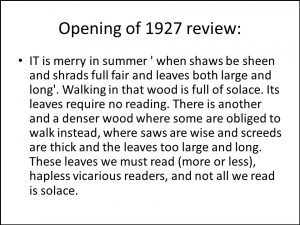
IT is merry in summer ‘ when shaws be sheen and shrads full fair and leaves both large and long’. Walking in that wood is full of solace. Its leaves require no reading. There is another and a denser wood where some are obliged to walk instead, where saws are wise and screeds are thick and the leaves too large and long. These leaves we must read (more or less), hapless vicarious readers, and not all we read is solace. (Opening of YWES 1927)
Well, what can I say! We’ve moved up a notch here, haven’t we? This is the cry of desperation of a “hapless” academic, locked inside on a glorious summer’s day, with a book review deadline looming over his head!!! (It sounds like my summers!!!) Here we have another simile: walking in the shady woods on a warm summer’s day, their leaves compared to those other “leaves”, the leaves of the piles of books Tolkien has to read and review– most definitely NOT what he wants to be doing, but do it he must! (note that the metaphorical wood in the simile is “dense” and the leaves are “too large and long”)
The quotation with which Tolkien begins, which critic S.J. Ryan (2004) has linked to “Leaf by Niggle” as well as Aragorn and the fellowship walking in the woods of Lothlórien in The Lord of the Rings, comes from one of the Robin Hood ballads, collected by Percy and also printed by Child, and believed to be one of the oldest ones with a “mythological” aspect. Here it is, as it appears reprinted in Popular British Ballads from 1894:

WHEN shaws been sheen, and shrads full fair,
And leaves both large and long/
It is merry walking in the fair forrest,
To hear the small bird’s song.
Tolkien only changes the stanza around a little and paraphrases, but keeps the first two lines intact:
IT is merry in summer ‘when shaws be sheen and shrads full fair and leaves both large and long’. Walking in that wood is full of solace.

Now if I have it right, I don’t think anyone else has identified the quotation before – and if I am wrong I am sure one of the eminent scholars in this room will tell me so. We also know that Tolkien had heard a paper by G.B. Smith on “Early English Ballads” in King Edward’s School in 1911 (Garth, 2003, p. 352), so there’s clearly a bit more sleuth work to be done here, and perhaps a reconsideration of Tolkien’s knowledge of the Robin Hood legend and what bearing this may have in his portrayal of “outlaws” in the legendarium – of which there are a fair few.
You see that – already – a close reading of these very academic (and often very heavy-going and technically challenging) reviews opens up new vistas and proves a pretty fruitful exercise. What I hope to do in the remained of this talk is share some further insights into Tolkien’s ideas, creativity and philosophy that these reviews reveal, and I have structured these under the following categories:
 Biographical insights
Biographical insights- The usual suspects, and
- Echoes of Middle-earth
Let me take these one-by-one: starting with biographical insights.
I talked a minute ago about Tolkien’s comment on the Great War, as opposed to the more glorious wars of antiquity. It shouldn’t surprise us that comments and asides about the War found their way in Tolkien’s book reviews – after all this was all a very recent (and rather painful) experience for him. Characteristically, he handles such references with humour, but also with a certain bitterness at times.
Two such instances come when Tolkien is reviewing A Concise Etymological Dictionary of Modern English, by E. Weekley. Tolkien notes:
The dictionary is specially strong in recording, if not in etymologizing, recent neologisms, americanisms, slang, and war-words—but bumf… has escaped Mr. Weekley’s trawler. (YWES 1926, p. 50)

 Bumf is an interesting word, originally 19th-century schoolboy slang, a shortened form of “bum-fodder”, i.e. toilet paper, but later appropriated by WWI soldiers to refer to excessive (and largely irrelevant) military paperwork, and eventually associated with the junk mail of our daily existence today. Tolkien is clearly familiar with it from his own war days, as he also is with the word blimp and the menacing presence of its signifieds. Here is a picture of blimps over London. Tolkien objects to the etymology of blimp given by Weeekley:
Bumf is an interesting word, originally 19th-century schoolboy slang, a shortened form of “bum-fodder”, i.e. toilet paper, but later appropriated by WWI soldiers to refer to excessive (and largely irrelevant) military paperwork, and eventually associated with the junk mail of our daily existence today. Tolkien is clearly familiar with it from his own war days, as he also is with the word blimp and the menacing presence of its signifieds. Here is a picture of blimps over London. Tolkien objects to the etymology of blimp given by Weeekley:

Blimp might, finally, be cited as an example of less successful guessing. An air-officer suggested ‘bloody limp’ to Mr. Weekley; but the word was in use before the air-force had much success in making German captive-balloons even unqualifiedly limp; they hung swollen and menacing upon many an horizon. And the word was applied to our own. It is perhaps more in accordance with their looks, history, and the way in which words are built out of the suggestions of others in the mind, if we guess that blimp was the progeny of blister + lump, and that the vowel i not u was chosen because of its diminutive significance—typical of war-humour. (YWES 1926, pp. 51-2)
I think I can sort of “feel” Tolkien slightly shuddering here, remembering these enormous structures hanging “swollen and menacing upon many an horizon”. But he quickly also captures the dark side of war-humour: instead of blister + lump making “blump”, which would give a sound symbolic sense of something swollen and big, the word ended up being “blimp”, something swollen but little, the front vowel “i” usually associated with smallness in contrast to the back vowel “ə”, which implies something larger. Black humour is typical of war and other similar dark circumstances – “blimp” is a diminutive, ironic pet-name (in the same vein of calling Robin Hood’s gigantic chief lieutenant Little John), though it is associated with far more deadly and perilous things…
Tolkien also mentions the war when he discusses philology and its German origins and tradition. I said earlier on, that the journal for which Tolkien reviewed stopped featuring an article on philology in the 1940s and that philology was already in danger of decline in the 1920s, when Tolkien was writing these reviews. But philology was in his heart and soul, a way of merging the study of language and literature rather than artificially divorce them from each other with consequent intellectual losses on both sides. Tolkien was at that time very much involved in another “war” within his own Faculty at Oxford about the English syllabus over how much ‘Lit’ or ‘Lang’ students should be taught, and wrote about philology as the natural way to bring these two together. It is with vexation therefore, after having spent two full pages going through René Huchon’s Histoire de la Langue anglaise, mainly picking on all sorts of problems and issues, that he notes:
 These remarks are tempered by regret that they do not reflect more plainly the cordiality with which we should wish to greet any mark of attention shown by French philology to English matters.
These remarks are tempered by regret that they do not reflect more plainly the cordiality with which we should wish to greet any mark of attention shown by French philology to English matters.
Not that the danger at the moment is one of excessive reverence for German ideas or achievement. Indeed, not only is the great contribution of German-speaking scholars liable to be foolishly belittled, but ‘philology’ itself, conceived as a purely German invention, is in some quarters treated as though it were one of the things that the late war was fought to end (and certainly, we think, will not); (YWES 1924, pp. 36-7)
No, its German scholarly origin and tradition wasn’t the only reason for the decline of philology, but it certainly didn’t help. Tolkien here is “fighting the long defeat” through his review – all the more heroic because unsuccessful.
My next category is the “usual suspects”, those concepts and ideas that we know from other works and writings that Tolkien was keenly interested in, and which surface rather naturally in his book reviews. He often talks about his fascination with words and the beauty of lexicography. While reviewing an article on etymologies of a group of related Germanic words he points out:
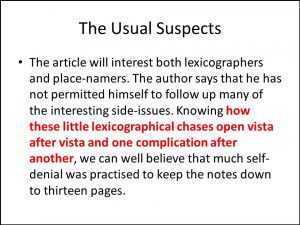 The article will interest both lexicographers and place-namers. The author says that he has not permitted himself to follow up many of the interesting side-issues. Knowing how these little lexicographical chases open vista after vista and one complication after another, we can well believe that much self-denial was practised to keep the notes down to thirteen pages. (YWES 1927, p. 35)
The article will interest both lexicographers and place-namers. The author says that he has not permitted himself to follow up many of the interesting side-issues. Knowing how these little lexicographical chases open vista after vista and one complication after another, we can well believe that much self-denial was practised to keep the notes down to thirteen pages. (YWES 1927, p. 35)
To me this brings to mind “Leaf by Niggle” again, and the attention to detail that opened up Tolkien’s imagination to consider further minute details, leading to other details, both in his legendarium and in his scholarly work, thus NOT practicing “self-denial” and neglecting the larger “tree” of his mythology, or of his academic writings.
 Elsewhere he gives us a wistful and perceptive point about dictionaries:
Elsewhere he gives us a wistful and perceptive point about dictionaries:
But a perfect dictionary is an attractive mirage, and its nearest possible realization an aesthetic joy— appreciated most by those least in need of it. (YWES 1927, p. 36)
One can’t help but think of the numerous dictionaries and lexicons that Tolkien devised for his invented languages, the Qenya Lexicon, the Gnomish Lexicon, the Etymologies, all unfinished, all promising the beauty of perfection, and all “appreciated most by those least in need” of them – Tolkien himself of course. And do forgive me for bringing in David Bowie, but his point, I think, complements Tolkien’s really well:
“Don’t you love the Oxford Dictionary? When I first read it, I thought it was a really really long poem about everything.”
Tolkien himself, of course, worked on the OED before he got his first academic post in Leeds, and we know that the entries he was responsible for where all under the letter W. It was his fortune, then, to have to include in his book reviews the latest instalments of the OED, all picking up where he left with further words starting with W, and often words he researched himself but did not write-up. His confidence and pleasure at evaluating his former colleagues’ efforts are demonstrated by his relaxed style and humorous asides. In his first review he writes:
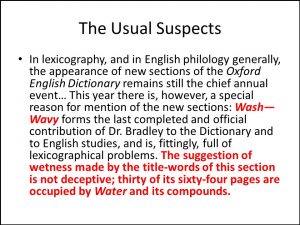 In lexicography, and in English philology generally, the appearance of new sections of the Oxford English Dictionary remains still the chief annual event… This year there is, however, a special reason for mention of the new sections: Wash— Wavy forms the last completed and official contribution of Dr. Bradley to the Dictionary and to English studies, and is, fittingly, full of lexicographical problems. The suggestion of wetness made by the title-words of this section is not deceptive; thirty of its sixty-four pages are occupied by Water and its compounds. (YWES 1923, pp. 20-1)
In lexicography, and in English philology generally, the appearance of new sections of the Oxford English Dictionary remains still the chief annual event… This year there is, however, a special reason for mention of the new sections: Wash— Wavy forms the last completed and official contribution of Dr. Bradley to the Dictionary and to English studies, and is, fittingly, full of lexicographical problems. The suggestion of wetness made by the title-words of this section is not deceptive; thirty of its sixty-four pages are occupied by Water and its compounds. (YWES 1923, pp. 20-1)
In his second review he notes:
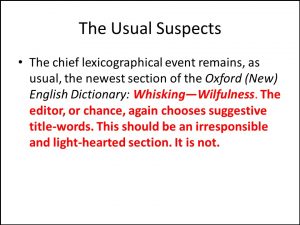 The chief lexicographical event remains, as usual, the newest section of the Oxford (New) English Dictionary: Whisking—Wilfulness. The editor, or chance, again chooses suggestive title-words. This should be an irresponsible and light-hearted section. It is not. (YWES 1926, pp. 47-8)
The chief lexicographical event remains, as usual, the newest section of the Oxford (New) English Dictionary: Whisking—Wilfulness. The editor, or chance, again chooses suggestive title-words. This should be an irresponsible and light-hearted section. It is not. (YWES 1926, pp. 47-8)
Tolkien reviews both sets of entries magnanimously, but he also takes the chance to question them when they didn’t take up his own etymological suggestions during his preliminary research.
One theme that comes up again and again throughout the three reviews, as it also does throughout Tolkien’s legendarium, is a fascination with England’s Anglo-Saxon past. Tolkien continuously betrays his interest in the adventus saxonum, the process via which the Anglo-Saxons arrived in Britain and changed its culture forever, and seems also very excited at the possibility of place-name studies recovering linguistic elements of the native British languages that were there before Old English. He comments on Germanic gods in English place-names (chiefly Woden), and he quotes verbatim (with what seems to me to be sheer exhilaration) O. G. S. Crawford’s explanation of why place-name studies are so important:
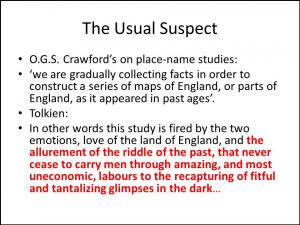
‘we are gradually collecting facts in order to construct a series of maps of England, or parts of England, as it appeared in past ages’. (YWES 1926, p. 65)
Now one can imagine what an impression this statement would have made on Tolkien. He follows the quotation from Crawford with these words:
In other words this study is fired by the two emotions, love of the land of England, and the allurement of the riddle of the past, that never cease to carry men through amazing, and most uneconomic, labours to the recapturing of fitful and tantalizing glimpses in the dark… (YWES 1926, p. 65)
Well, if the entire project of Tolkien’s mythology is not the prime example of an “amazing, and most uneconomic, labour” to recapture “fitful and tantalizing glimpses” of England’s mythical/imaginary past, then I don’t know what is!
Tolkien also mentions other research into Old English texts and motifs that we know were significant for his legendarium. He comments on a new article “on the OE. charm against elfshot” (Tom Shippey has linked this with Tolkien’s elves’ skill with archery) and on a proposed new etymology of the name Beowulf, yielding the sense “wind wolf” rather than the usual “bee wolf”, i.e. bear.
And, by mentioning Beowulf, I am now passing into my third category: echoes of Middle-earth in these book reviews.
 Commenting on an article on “Place-names and Archaeology” Tolkien notes:
Commenting on an article on “Place-names and Archaeology” Tolkien notes:
the gem is on the first page—a delightful illustration of what at the best may be hoped for (though hope may rarely be rewarded) from the alliance of Philologia and Archaeologia. The expression on fāgne flōr occurs in Beowulf 725, and might be guessed to mean paved or even tessellated floor. Fawler in Oxfordshire claims as earliest form Fauflor (1205). ‘Æt þam fāgan flōre?’ says the philologist; ‘was there a Roman tessellated pavement?’ The archaeologist replies: ‘at the south end of the village a Roman villa with a tessellated pavement was discovered in 1865’. (YWES 1926, p. 64)
Here are the lines from Beowulf Tolkien refers to and here is his own translation of these lines – I have highlighted the particular phrase about the floor:
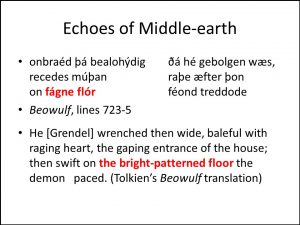
onbraéd þá bealohýdig ðá hé gebolgen wæs,
recedes múþan raþe æfter þon
on fágne flór féond treddode
Beowulf, lines 723-5
He [Grendel] wrenched then wide, baleful with raging heart, the gaping entrance of the house; then swift on the bright-patterned floor the demon paced. (Tolkien’s Beowulf translation, p. 33)
And here is the tessellated pavement in the Roman villa in Oxfordshire that the article Tolkien has reviewed is referring to.

These Beowulf lines for sure, and perhaps even this image of the real floor, found their way in The Lord of the Rings, in the description of Meduseld when Gandalf, Aragorn, Legolas and Gimli enter:
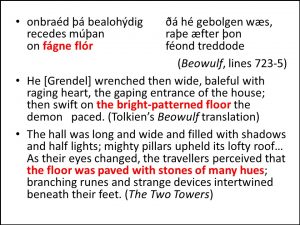 The hall was long and wide and filled with shadows and half lights; mighty pillars upheld its lofty roof… As their eyes changed, the travellers perceived that the floor was paved with stones of many hues; branching runes and strange devices intertwined beneath their feet. (LotR, p. 512)
The hall was long and wide and filled with shadows and half lights; mighty pillars upheld its lofty roof… As their eyes changed, the travellers perceived that the floor was paved with stones of many hues; branching runes and strange devices intertwined beneath their feet. (LotR, p. 512)
But for me another instance in which I got a sudden dejavu and a flash of a scene from The Lord of the Rings, was Tolkien’s review of an essay on English personal names and their peculiar and often comical ‘attributes’:
the chief and longest part of this chapter deals with the ‘attributes’ (e. g. Stoke D’Abernon), of various kinds, origins, and meanings; with their distribution, dating, and interpretation. These attributes are the elements that perhaps most quickly catch the casual eye in English names; they provide jokes for American comic papers, and humorous bogus names in our own; and of course the philologist pure and simple cannot deal with them by himself. The author of the chapter amusingly juxtaposes the comic Bagpuize, Bubb, Coggles, Goose, Gubbals, Pudding, Wallop (some of these are less well known than they deserve) and the chivalric Champflower, D’Evercy, Lancelyn, Montague, Morieux, and others. (YWES 1926, p. 60)

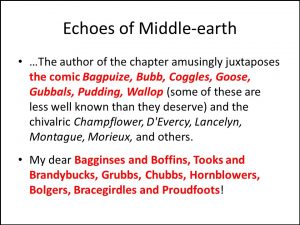
Well, the first string of “comic” but very traditionally English names, brought immediately to my mind:
My dear Bagginses and Boffins, Tooks and Brandybucks, Grubbs, Chubbs, Hornblowers, Bolgers, Bracegirdles and Proudfoots! (LotR, p. 29)
If the hobbits are another aspect of Tolkien’s representation of Englishness, then those names are fittingly English and comic, very much in the spirit of the names cited in the essay Tolkien reviewed.
I would like to close this paper with a few more gems from Tolkien’s reviews, which I will not analyse or discuss too much, but which I wish to leave with you to ponder about, and which may reveal further aspects of Tolkien’s intellect, creativity and humour.
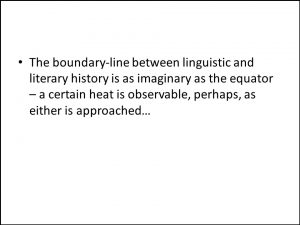
First, two similes in which Tolkien borrows from geography and palaeontology respectively. He writes:
The boundary-line between linguistic and literary history is as imaginary as the equator – a certain heat is observable, perhaps, as either is approached… (YWES 1927, p. 59)
Here we are back in the ‘lit’ and ‘lang’ territory and Tolkien’s creative use of imagery from geography to show that these two are not as separate as his colleagues may want to think – indeed, the line that divides them is as “real” as the equator.
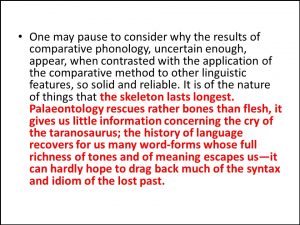 While marvelling about the capacity of philology to “excavate” lost and forgotten languages he notes:
While marvelling about the capacity of philology to “excavate” lost and forgotten languages he notes:
One may pause to consider why the results of comparative phonology, uncertain enough, appear, when contrasted with the application of the comparative method to other linguistic features, so solid and reliable. It is of the nature of things that the skeleton lasts longest. Palaeontology rescues rather bones than flesh, it gives us little information concerning the cry of the taranosaurus; the history of language recovers for us many word-forms whose full richness of tones and of meaning escapes us—it can hardly hope to drag back much of the syntax and idiom of the lost past. (YWES 1927, pp. 55-6)
So yes, philology can rescue and restore the “skeleton” of dead languages, its bare bones, its main structures and characteristics. But it cannot bring it back fully alive – it can’t give us idioms, syntax, connotations, pronunciation. Just like palaeontology can’t tell us how the dinosaurs sounded like. Philology, therefore, satisfies both of Tolkien’s well-known desires: the re-discovery or restoration of the past, but also the inevitable gaps in our knowledge, the romance of things of the past that are now lost forever, and we can only imagine them and attempt to recapture them in fantasy.
Second, two examples of sheer humour, lest we forget that melancholy and nostalgia is only one of Tolkien’s “modes” – wit and light-heartedness is another, and equally powerful at times:
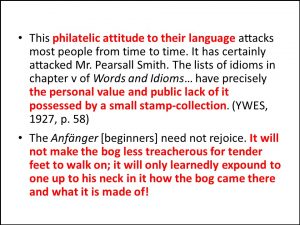 Passing pretty harsh judgement on the efforts demonstrated in Words and Idioms: Studies in the English Language, he says:
Passing pretty harsh judgement on the efforts demonstrated in Words and Idioms: Studies in the English Language, he says:
This philatelic attitude to their language attacks most people from time to time. It has certainly attacked Mr. Pearsall Smith. The lists of idioms in chapter v of Words and Idioms… have precisely the personal value and public lack of it possessed by a small stamp-collection. (YWES 1927, p. 58)
Here Tolkien manages to insult both Mr Pearsall Smith and philatelists with small stamp-collections!
Commenting on an article on Old English phonology and its intricate methodology he says:
The Anfänger [beginners] need not rejoice. It will not make the bog less treacherous for tender feet to walk on; it will only learnedly expound to one up to his neck in it how the bog came there and what it is made of! (YWES 1927, p. 43)
And, to close, may I leave you with just one short phrase, which Tolkien only uses in passing, but which may prove – I think – to be a worthy addition to all of those other proverbial “wise sayings” which The Lord of the Rings is full of. I will say it just once and let you think about it:
rumour is mythopoetic (YWES 1926, p. 43)

Thank you ever so much for listening!
Works Cited
“About the Journal”, The Year’s Work in English Studies, available at: https://academic.oup.com/ywes/pages/About
Garth, John (2003) Tolkien and the Great War: The Threshold of Middle-earth, London: HarperCollins.
Johnson, R. Brimley (1894) Popular British Ballads: Ancient and Modern, Vol. 1, London: J. M. Dent; Philadelphia: J. B. Lippincott Company.
Ryan, J.S. (2004) ‘Folktale, Fairy Tale, and the Creation of a Story’, in Isaacs, Neil D. and Zimbardo, Rose A. (eds.) Understanding the Lord of the Rings: The Best of Tolkien Criticism, Boston: Houghton Mifflin.
Tolkien, J.R.R. (1924) ‘Philology: General Works’, The Year’s Work in English Studies, 4, pp. 20–37, available at: https://doi.org/10.1093/ywes/IV.1.20
Tolkien J.R.R. (1926) ‘Philology: General Works’, The Year’s Work in English Studies, 5, pp. 26–65, available at: https://doi.org/10.1093/ywes/5.1.26
Tolkien, J.R.R. (1927) ‘Philology: General Works’, The Year’s Work in English Studies, 6, pp. 32–66, available at: https://doi.org/10.1093/ywes/VI.1.32
Tolkien, J.R.R. (2004) The Lord of the Rings, 50th Anniversary Edition, edited by Wayne G. Hammond & Christina Scull, London: HarperCollins.
Tolkien, J.R.R. (2014) Beowulf: A Translation and Commentary, Together with Sellic Spell, edited by Christopher Tolkien, London: HarperCollins.
